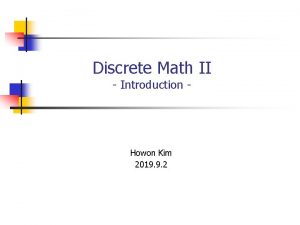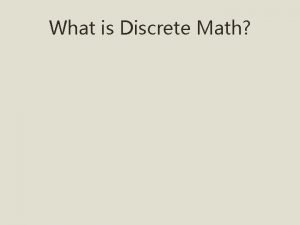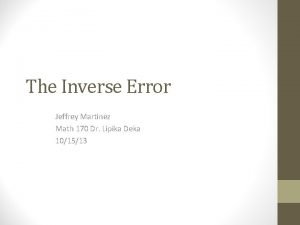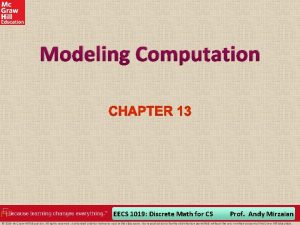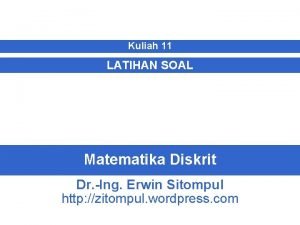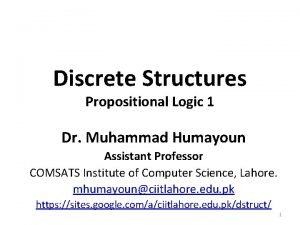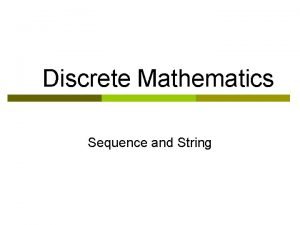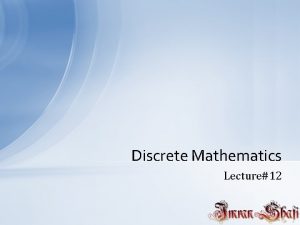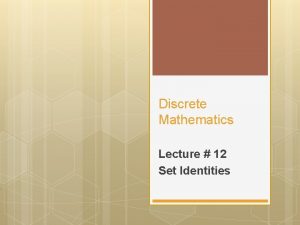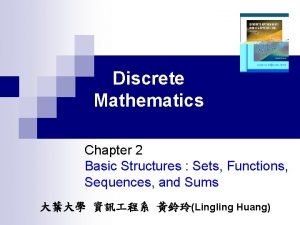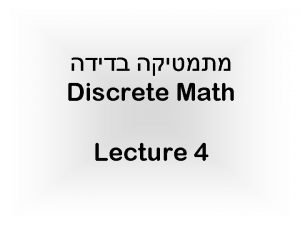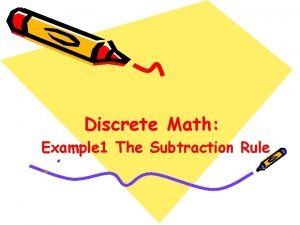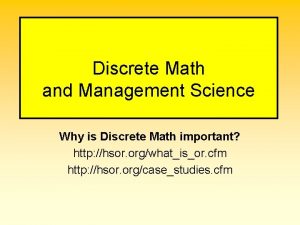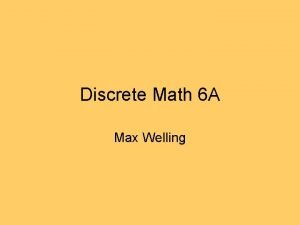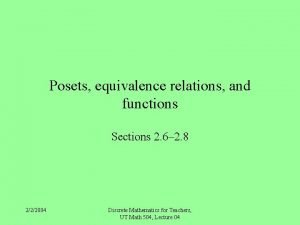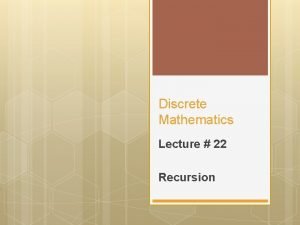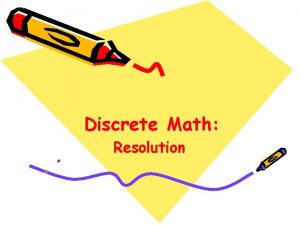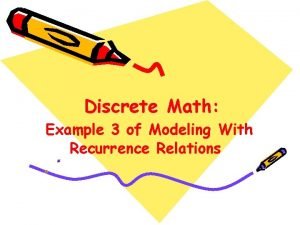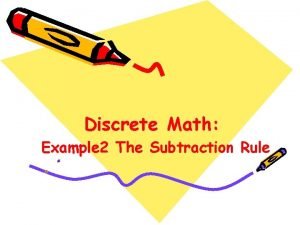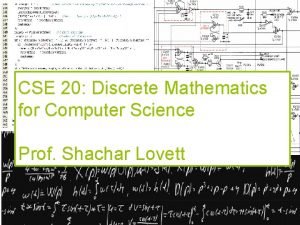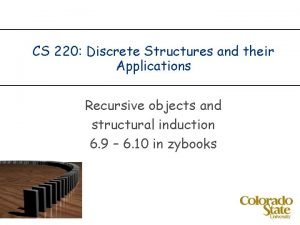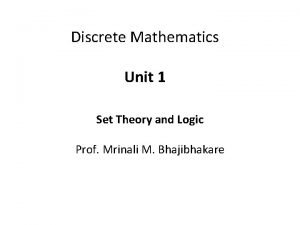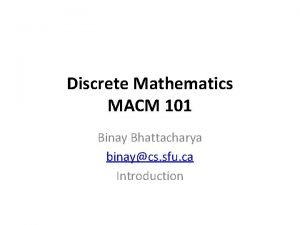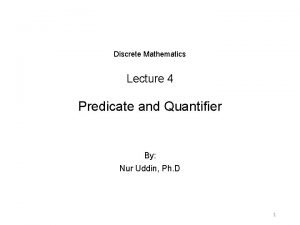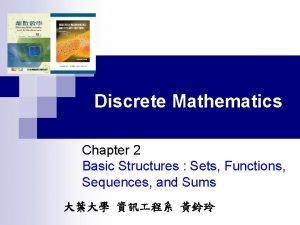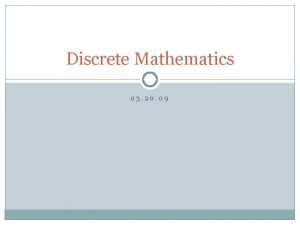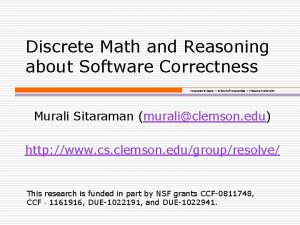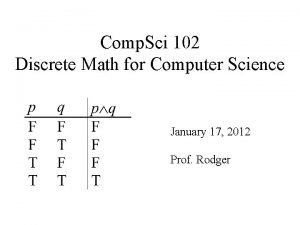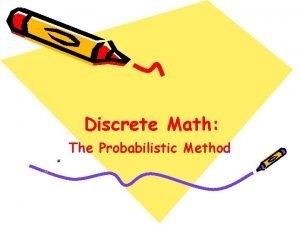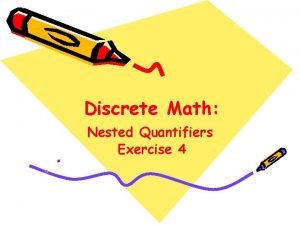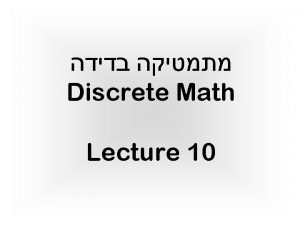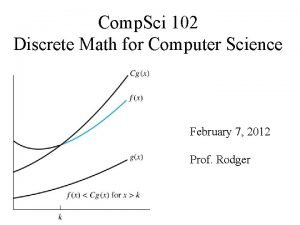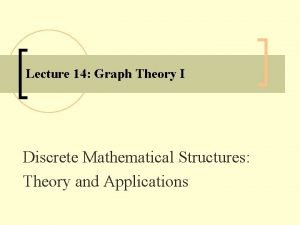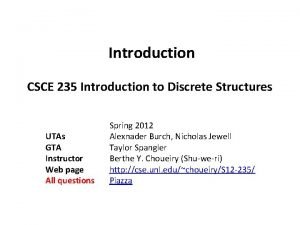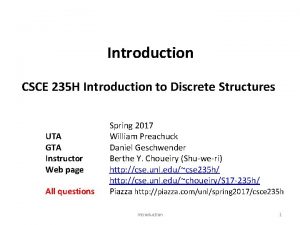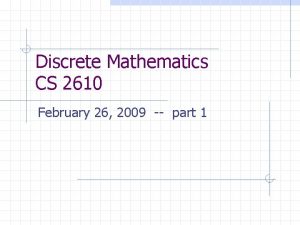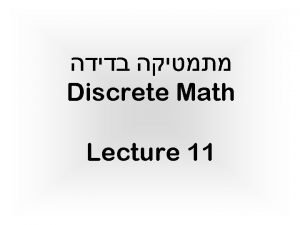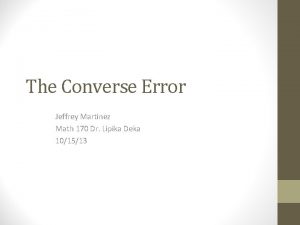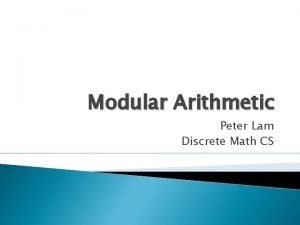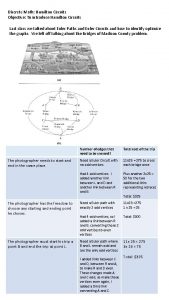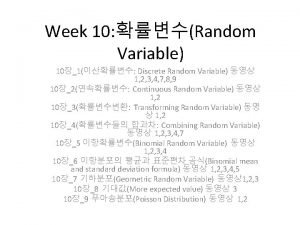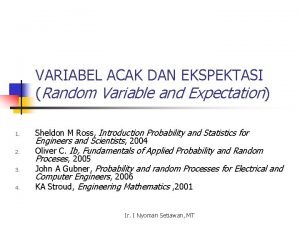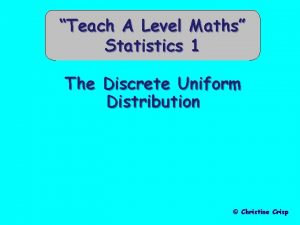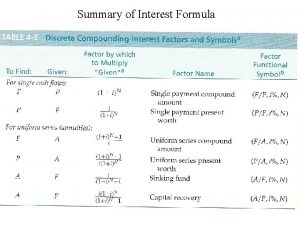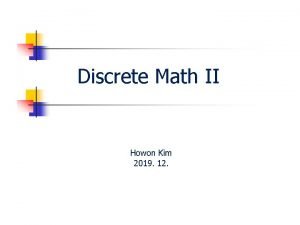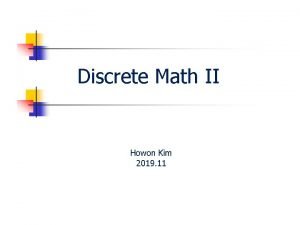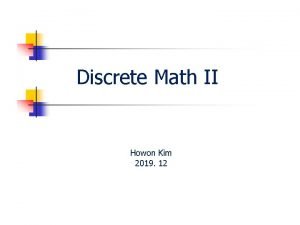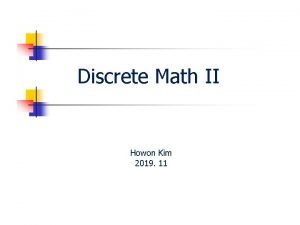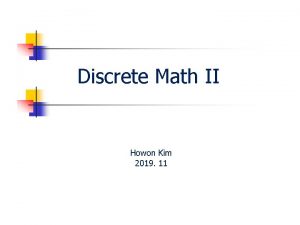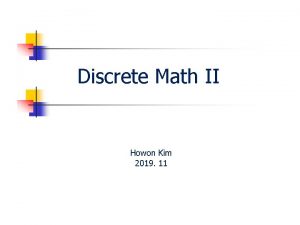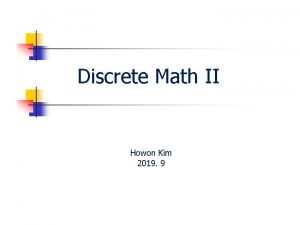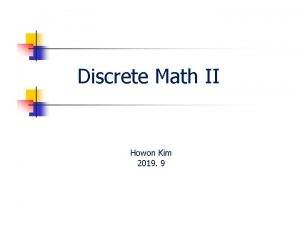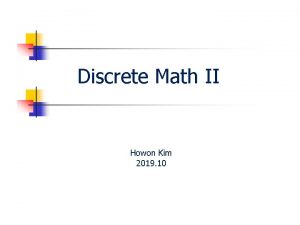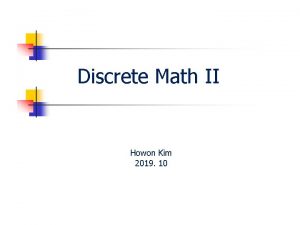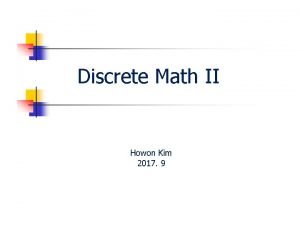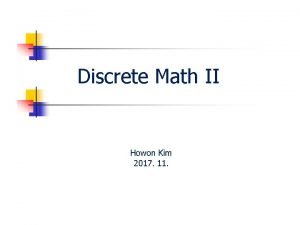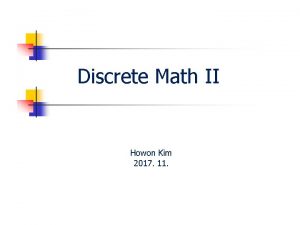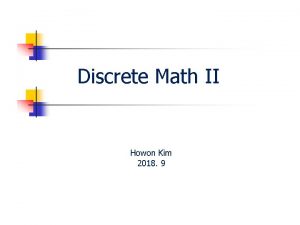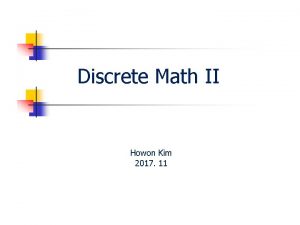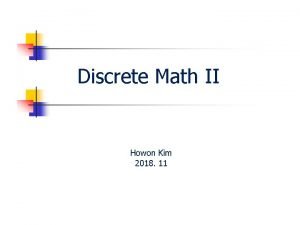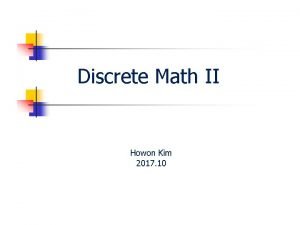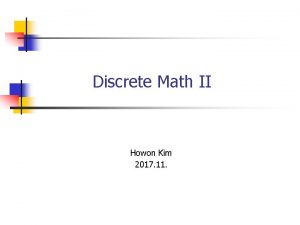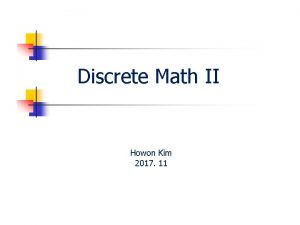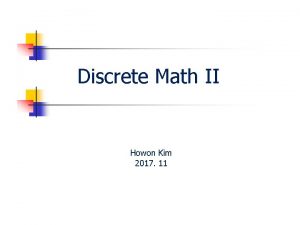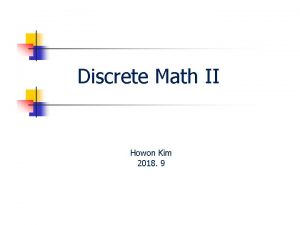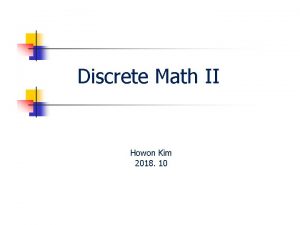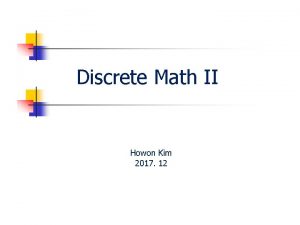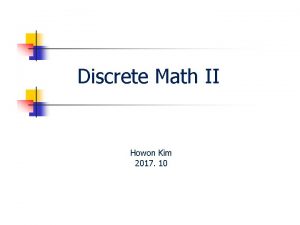Discrete Math II Howon Kim 2019 9 Agenda





























![Unit in Zn Theorem 4 곱셈에 대한 역원가짐 In Zn, [a] is a unit Unit in Zn Theorem 4 곱셈에 대한 역원가짐 In Zn, [a] is a unit](https://slidetodoc.com/presentation_image_h/fa8d703438187573f8984302a4941ad1/image-30.jpg)







![Zn* vs. (n) Definition of Zn* The set of the equivalence class [m] in Zn* vs. (n) Definition of Zn* The set of the equivalence class [m] in](https://slidetodoc.com/presentation_image_h/fa8d703438187573f8984302a4941ad1/image-38.jpg)


















- Slides: 56

Discrete Math II Howon Kim 2019. 9

Agenda n 1 Algebra, group, ring n 2 Modular arithmetic n 3 Euclidean algorithm 2

Algebra Definition Tuple <K, op 1, op 2, …, opn> < R, , > < {T, F }, , , > ; Boolean algebra K : a set of data |K| : order finite or infinite Operator opj Closure opj : Ki K Unary if i=1, Binary if i=2, … 3

Identity and Zero : K K K Identity element e for in K (항등원) e a = a e = a for all a ∈ K Zero element z for in K (영원) z a = a z = z for all a ∈ K Examples < Z, + > Identity : 0, Zero : none < Z, > Identity : 1, Zero : 0 4

Inverse : K K K Let e be the identity element for in K. Left inverse Right inverse a’L a = e , a ∈ K a a’R = e , a ∈ K If a’L = a’R = a’ , a’ is the inverse of a. Example < Z, + > Identity 0, (-x) is the inverse of x : x + (-x) = (-x) + x = 0 5

Properties of Operator Let : K K K be a binary operator. (1) Closure (2) Associative (a b) c = a (b c) for all a, b, c ∈ K. (3) Identity There is an identity element e ∈ K for . (4) Inverse For each a ∈ K, there is an inverse a’ ∈ K for . (5) Commutative a b = b a for all a, b ∈K. 6

Binary Algebra < K, > for binary operator : K K K 1. Semigroup (반군) : Associative 2. Monoid (단위반군) : Associative, Identity 3. < N, + >, < Z, >, < {T, F }, > A monoid is a set that is closed under an associative binary operation and has an identity element Group (군) : Associative, Identity, Inverse 4. < Z+, + > A semigroup is a set with an associative binary operation which satisfies closure and associative law. < Z, + > Abelian group (대수군) : Associative, Identity, Inverse, Commutative < Z, + > 7

Binary Algebra < K, > Set (1), (2) Properties (1) (2) (3) (4) (5) Closure Associativ e Identity Inverse Commutati ve Semigroup (5) Abelian Monoid (5) Abelian Group (3) Monoid (4) Group 8

Binary Algebra Set Closure Semigroup Associative Abelian Semigroup Abelian Monoid Abelian Group Identity Group Inverse Commutative 9

Ring ( Two operators ) < K, , > Two binary operators , : K K K Conditions for Ring < K, > is an abelian group. is associative is distributive over a (b c) = (a b) (a c) and (a b) c = (a c) (b c) for all a, b, c ∈ K. 10

Definitions < K, , > < K, > : abelian group, and distribution laws hold Conditions for operator : 1. Ring (환) : Associative 2. Ring with Unity : Associative, Identity Commutative Ring : Associative, Commutative Ring with Unity 3. 4. Associative, Identity, Commutative 5. Field (체) 11

Ring and Field < K, , > Set (0), (1), (2) Properties for (0) Distributive (1) Closure (2) Associative (3) Identity (4) Inverse (5) Commutative Ring (5) (3) Ring with Unity Commutative Ring (3) (5) Commutative Ring with Unity (4) Field 12

Ring and Field < K, , > Closure Distributive Ring Associative Ring with Unity Identity Field Inverse Commutative Ring with Unity Commutative Ring Commutative 13

Example: Square Matrix < K, , > K : a set of n n matrix : matrix addition : matrix multiplication Distributive over < K, > Closure, Associative, Identity (zero matrix), Inverse, Commutative Abelian Group < K, > Closure, Associative, Identity Not Commutative, Not Inverse For the first operation, it is an Abelian group, and for the second operation, there is a identity (also it is closed and associative) “Ring with unity” 14

Group/Ring/Integral Domain/Field In this case, the first operation is “addition” and the second one is “multiplication” 15

Example: Ring and Field Rings for < K, , > : ordinary addition : ordinary multiplication K : 정수, 유리수, 실수 , 복소수 < Z, +, · >, < Q, +, · >, < R, +, · >, < C, +, · > Ring but not Field (정수) < Z, +, · > : not Inverse for · Field (유리수, 실수, 복소수) < Q, +, · >, < R, +, · >, < C, +, · > (Note) Inverse For nonzero elements 16

Agenda n 1 Algebra, group, ring n 2 modular arithmetic n 3 Euclidean algorithm 17

Congruence Modulo n Definition Let n Z+, n > 1. For a, b Z, we say that a is congruent to b modulo n, and we write a b (mod n), if n|(a-b), or equivalently, a = b + kn for some k Z. 17 2 (mod 5) ; 17 = 2 + 3 5 -7 -49 (mod 6) ; -7 = -49 + 7 6 Theorem 1 Congruence modulo n is an equivalence relation on Z. (note) m|n : m divides n, for m, n Z, m 0 18

Equivalence Classes Note that an equivalence relation on a set induces a partition of the set. Congruence modulo n ( 2) partitions Z into the n equivalence classes. [0] = { 0+nx | x Z } = {. . , -n, 0, n, . . } [1] = { 1+nx | x Z } = {. . , 1 -n, 1, 1+n, . . } [2] = { 2+nx | x Z } = {. . , 2 -n, 2, 2+n, . . } : [n-1] = { (n-1)+nx | x Z } = {. . , -1, n-1, 2 n-1, . . } 19

Zn For all t Z, t = qn + r (0 r < n), so t [r] or [t] = [r]. Zn = { [0], [1], . . . , [n-1] } Two closed operators on Zn : + and [a] + [b] = [a+b] and [a] [b] = [a][b] = [ab] For n = 7, [2] + [6] = [2+6] = [8] = [1], and [2][6] = [12] = [5]. 20

Zn , n=7. . . -21 -20 -19 -18 -17 -16 -15 -14 -13 -12 -11 -10 -9 -8 -7 -6 -5 -4 -3 -2 -1 0 7 14 21 28. . . 1 8 15 22 29 2 9 16 23 30 3 10 17 24 31 4 11 18 25 32 5 12 19 26 33 6 13 20 27 34 21

Zn is a field ? Theorem 2 For n Z+, n > 1, under the two closed operators, Zn is a commutative ring with unity [1] (and additive identity [0] ). (Ex. ) < Z 5, +, > Field + 0 0 0 1 1 2 2 3 3 4 4 0 0 0 1 0 2 0 3 0 4 0 1 2 2 3 3 4 4 0 0 1 1 2 0 0 1 2 2 4 3 1 4 3 3 4 4 0 0 1 1 2 2 3 3 4 0 0 3 4 1 3 4 2 2 1 (Note) Inverse : for nonzero elements 22

continue (Ex. ) < Z 6, +, > Not Field + 0 0 0 1 1 2 2 3 3 4 4 5 5 0 0 0 1 0 2 0 3 0 4 0 5 0 1 2 2 3 3 4 4 5 5 0 0 1 1 2 0 0 1 2 2 4 3 0 4 2 5 4 3 4 4 5 5 0 0 1 1 2 2 3 3 4 0 0 3 4 0 2 3 0 0 4 3 2 5 5 0 1 2 3 4 5 0 5 4 3 2 1 Unit proper divisors of zero 23

Unit Definition 24

Zn with a prime n Theorem 3 Zn is a field if and only if n is a prime. ( proof of ) Let n is a prime, and suppose that 0 < a < n. Then gcd(a, n) = 1, so as we learned that there are integers s, t with as + tn = 1. Thus as 1 (mod n), or [a][s] = [1]. Since [a] is a unit of Zn, which is a consequently a field. 25

Zn with a prime n (Note 1) as + bt = gcd(a, b) Text p. 231 (Theorem 4. 6): Bezout’s identity For all a, b Z+, the following equation is satisfied. 단, s, t는 유일하지 않음 gcd(a, b) = as + bt, for some s, t Z Reference) Wikipedia (Note 2) Unit The element that has the multiplicative inverse, in a ring with unity 26

Zn with a prime n Theorem 3 Zn is a field if and only if n is a prime. ( proof of ) If n is not a prime, then n =n 1*n 2, where 1<n 1, n 2<n. So [n 1]!=[0] and [n 2]!=[0] but [n 1][n 2]=[n 1*n 2]=[0] (can be), and Zn is not even an integral domain. So it cannot be a field. (Note) Integral domain: no zero divisor + commutative ring No zero divisor : if a, b in S and a*b=0, then either a=0 or b=0 27

Zn with a prime n Theorem 3 Zn is a field if and only if n is a prime. ( proof of ) if Zn is a field, [a] is a unit for 0 < a < n. Then there is the s (0 < s < n) such that [a][s] = [1]. So as 1 (mod n) and as = 1 + tn. Then, as + (-t)n = 1 that is the smallest number among { ax+ny | x, y Z, ax+ny > 0 } 0보다 큰 수 중에서 가장 작은 값은 1이며, Therefore, gcd(a, n) = 1 and n is a prime. Bezout’s identity에 의해 1인 경우, gcd(a, n)=1이 됨. 이는 n이 prime 임을 의미함 28

Unit in Zn Theorem 4 a와n이 common factor가 없다는 것은 서로소라는 의미 곱셈에 대한 역원가짐 In Zn, [a] is a unit if and only if gcd(a, n) = 1. ( proof 1) 29
![Unit in Zn Theorem 4 곱셈에 대한 역원가짐 In Zn a is a unit Unit in Zn Theorem 4 곱셈에 대한 역원가짐 In Zn, [a] is a unit](https://slidetodoc.com/presentation_image_h/fa8d703438187573f8984302a4941ad1/image-30.jpg)
Unit in Zn Theorem 4 곱셈에 대한 역원가짐 In Zn, [a] is a unit if and only if gcd(a, n) = 1. ( proof 2) gcd(a, n) = 1 = as + tn, for some s, t Z. Then, as = 1 - tn and [a][s] = [1]. So [a] is a unit. Let [a] Zn and [a]-1 = [s]. Then [as] = [a][s] = [1], so as 1 (mod n) and as = 1 + tn, for some t Z. Therefore, gcd(a, n) = 1. gcd(25, 72)=1 (Ex) Find [25]-1 in Z 72. not a prime number 1 = (-23)25 + 8(72) (-23)(25) 1 (mod 72) Therefore, [25]-1 = [-23] = [-23+72] = [49] 30

Unit in Zn (Ex. ) < Z 6, +, > n But gcd(5, 6) = 1. 1 = (5)(5)+(-4)(6), so [5]-1 = [5]. gcd(2, 6) 1, gcd(3, 6) 1, Not Field 0 0 0 1 0 2 0 3 0 4 0 5 0 1 2 0 0 1 2 2 4 3 0 4 2 5 4 3 4 0 0 3 4 0 2 3 0 0 4 3 2 5 0 5 4 3 2 1 a proper divisors of zero gcd(4, 6) 1. 31

Euler’s Phi Function complete set of residues is: 0. . n-1 reduced set of residues, in which those numbers (residues) are relatively prime to n eg for n=10, complete set of residues is {0, 1, 2, 3, 4, 5, 6, 7, 8, 9} reduced set of residues is {1, 3, 7, 9} number of elements in reduced set of residues is called the Euler Phi (Totient) Function ø(n) ø(10)=4 and the set is {1, 3, 7, 9} 32

Euler’s Phi Function Definition For n Z+ and n 2, let (n) be the number of positive integers m, where 1 m < n and m, n are relatively prime. This function is known as Euler’s phi function. When p 1, . . . , pt are distinct primes and ei 1 for all 1 i < t, (Note) relatively prime For m, n Z+ and 1 m < n, if gcd(m, n) = 1, then m, n are called relatively prime. 33

Examples (72) ? (20) ? 1, 3, 7, 9, 11, 13, 17, 19 34

Examples 35

Corollary Let p is a prime and e 1. If n = pe, (n) = pe-1 (p-1). If n = p, (n) = n-1. p=3, e=3인 경우, (27) = 32 (3 -1) = 18, (11) = 11 – 1 = 10 If gcd(m, n) = 1, then (mn) = (m) (n). m = 10 = 2 5, n = 27 = 33, (270) = (2 -1)(5 -1)(33 -32) = 4 18 = (10) (27) 36

Proof of (mn) = (m) (n) If gcd(m, n) = 1, then (mn) = (m) (n). 37
![Zn vs n Definition of Zn The set of the equivalence class m in Zn* vs. (n) Definition of Zn* The set of the equivalence class [m] in](https://slidetodoc.com/presentation_image_h/fa8d703438187573f8984302a4941ad1/image-38.jpg)
Zn* vs. (n) Definition of Zn* The set of the equivalence class [m] in Zn such that m is relatively prime to n is called Zn* = { [m] | gcd(m, n) = 1, 1 m < n } reduced set of residues Note that |Zn*| = (n). Z 10* = { 1, 3, 7, 9 } (10) = (2 5) = (2 -1)(5 -1) = 4 Z 15* = { 1, 2, 4, 7, 8, 11, 13, 14 } (15) = (3 -1)(5 -1) = 8 38

Example of Z 15* Multiplication Table of Z 15* · 1 2 4 7 8 11 13 14 1 1 2 4 7 8 11 13 14 2 4 7 8 4 8 14 1 8 1 13 2 14 13 4 11 1 2 11 4 7 14 2 13 11 7 1 14 13 11 8 7 11 11 7 14 2 13 1 8 4 13 13 11 7 1 14 8 4 2 14 14 13 11 8 7 4 2 1 < Z 15*, > Abelian Group for multiplication 1) Closed 2) Associative 3) Identity 4) Inverse 5) Commutative 39

Zn vs. (n) In general, For any n Z+, n > 1, there are (n) units and n-1 - (n) proper divisors of zero in Zn. Z 10* = { 1, 3, 7, 9 } (10) = (2 5) = (2 -1)(5 -1) = 4 40

Summary Zn Commutative Ring with Unity (n) units n-1 - (n) proper divisors of zero Zp Field * Zn Abelian Group for multiplication (p) = p-1 units Relatively prime or not 41

Agenda n 1 Algebra, group, ring n 2 Modular arithmetic n 3 Euclidean algorithm 42

Gcd 구하기 참고 Chapter 6 of Understanding Cryptography by Christof Paar and Jan Pelzl 43


Euclidean Algorithm (1) Algorithm to find the Greatest Common Divisor Euclid’s Algorithm is based on the following theorem: gcd(a, b) = gcd(b, a mod b) Proof: Let d=gcd(a, b). Then by definition of gcd, d|a and d|b. Also a can be expressed in the form: a = kb + r. since a mod b = r, it can be expressed as (a mod b) = a – kb for some k. Because d|b, d also divides kb. And d|a. Therefore, d|(a mod b). We already know d|b. So by gcd definition, d = gcd(b, a mod b) ! Conversely, if d = gcd(b, a mod b), then d|kb and thus d|[kb + (a mod b)], which is equivalent to d|a. Thus the set of common divisors of a and b is equal to the set of common divisors of b and ( a mod b). Relatively prime a and b are relatively prime if gcd(a, b) = 1. 45

Euclidean Algorithm (2) gcd(a, b) = gcd(b, a mod b) gcd(55, 22) = gcd(22, 55 mod 22) = gcd(22, 11) = gcd(11, 0)=11 gcd(18, 12) = gcd(12, 6) = gcd(6, 0) = 6 gcd(11, 10) = gcd(10, 1) = gcd(1, 0) = 1 Euclid's Algorithm to compute GCD(a, b): A=a, B=b while B>0 R = A mod B A = B, B = R return A 46

Euclidean Algorithm (3) Recursive Euclidean Algorithm Euclid (a, b) if b = 0 then return a else return Euclid (b, a mod b) fi Euclid (76, 16) ; 76 = 4 x 16 + 12 Euclid (16, 12) ; 16 = 1 x 12 + 4 Euclid (12, 4) ; 12 = 3 x 4 + 0 Euclid (4, 0) 4 47

Gcd & Extended Euclidean Algorithm 48

Finding the Multiplicative Inverse Extended Euclid algorithm to compute b-1 mod m If we equate A and B with A 3 and B 3 respectively, we can get the same Euclidean algorithm as shown previously. EXTENDED EUCLID(m, b) 1. (A 1, A 2, A 3)=(1, 0, m); (B 1, B 2, B 3)=(0, 1, b) 2. if B 3 = 0 return “no inverse” // no inverse 3. if B 3 = 1 return B 2 // – 1 B 2 = b mod m 4. Q = // Q: quotient 5. (T 1, T 2, T 3)=(A 1 – Q*B 1, A 2 – Q*B 2, A 3 – Q*B 3) 6. (A 1, A 2, A 3)=(B 1, B 2, B 3) 7. (B 1, B 2, B 3)=(T 1, T 2, T 3) 8. goto 2 49

Finding the Multiplicative Inverse n Extended Euclid algorithm to compute b-1 mod m n Throughout the computation, the following relationships hold: m. T 1+b. T 2=T 3 m. A 1+b. A 2=A 3 m. B 1+b. B 2=B 3 n n Also, if gcd(m, b)=1 then on the final step, A 3=1 and B 3=0. Also on the preceding step. B 3=1. In case of B 3=1, m. B 1+b. B 2=B 3 m. B 1+b. B 2=1 -m. B 1 b. B 2=1 (mod m) That is, B 2 ≡ b-1 mod m 50

The correctness of Multiplicative Inverse 51

The correctness of Multiplicative Inverse 52

The correctness of Multiplicative Inverse 53

Finding the Multiplicative Inverse https: //en. wikipedia. org/wiki/Extended_Euclidean_algorithm 54

Example: 550 -1 mod 1759 55

More on Bezout’s Identity Euclid’s Algorithm is more useful than simply giving an efficient way to determine the greatest common divisor of two numbers. It also yields a relationship between two numbers and their greatest common divisor that is of great importance, both practically and theoretically, as we shall see. The relationship is called: Theorem (Bezout’s Identity). If the greatest common divisor of a and b is d, then d = ar+bs for some integers r and s Solving Bezout’s Identity by Euclid’s Algorithm is often called the Extended Euclidean Algorithm <참고: A concrete introduction to higher algebra, p. 37~> 56
 Howon kim
Howon kim Howon kim
Howon kim Agenda sistemica y agenda institucional
Agenda sistemica y agenda institucional Discrete mathematics
Discrete mathematics Inverse error
Inverse error Modeling computation discrete math
Modeling computation discrete math Absorption law logic equivalence
Absorption law logic equivalence Contoh soal diskrit
Contoh soal diskrit Discrete math propositional logic
Discrete math propositional logic String in maths
String in maths Complement relation discrete math
Complement relation discrete math Set difference identities
Set difference identities Correspondence function examples
Correspondence function examples De morgan's laws logic
De morgan's laws logic What does onto mean in discrete math
What does onto mean in discrete math Subtraction rule in discrete mathematics
Subtraction rule in discrete mathematics What is discrete math
What is discrete math Discrete math cartesian product
Discrete math cartesian product Discrete mathematics with applications susanna s. epp
Discrete mathematics with applications susanna s. epp Poset discrete math
Poset discrete math Counterexample discrete math
Counterexample discrete math Recursion discrete math
Recursion discrete math Resolution discrete math
Resolution discrete math Recurrence discrete math
Recurrence discrete math Subtraction rule discrete math
Subtraction rule discrete math Knights and knaves discrete math
Knights and knaves discrete math Structural induction discrete math
Structural induction discrete math Set theory and logic discrete mathematics
Set theory and logic discrete mathematics Macm101
Macm101 Predicate discrete math
Predicate discrete math Sequence discrete math
Sequence discrete math Division algorithm in discrete mathematics
Division algorithm in discrete mathematics Discrete math
Discrete math Discrete mathematics
Discrete mathematics Discrete math tutor
Discrete math tutor Nested quantifiers exercises
Nested quantifiers exercises Binary relation examples
Binary relation examples Big-o notation discrete math
Big-o notation discrete math Discrete math
Discrete math What is discrete math
What is discrete math Webhandin unl
Webhandin unl Discrete mathematics
Discrete mathematics Inverse realtion
Inverse realtion Big o notation discrete math
Big o notation discrete math Discrete math
Discrete math Converse error
Converse error Modular arithmetic discrete math
Modular arithmetic discrete math Discrete math circuits
Discrete math circuits Math department meeting agenda
Math department meeting agenda Alabama course of study math
Alabama course of study math Topmarks
Topmarks Behavioral objectives
Behavioral objectives Discrete random variable
Discrete random variable Discrete wavelet transform 이란
Discrete wavelet transform 이란 Contoh continuous random variable
Contoh continuous random variable Discrete uniform distribution
Discrete uniform distribution Effective interest rate formula
Effective interest rate formula
